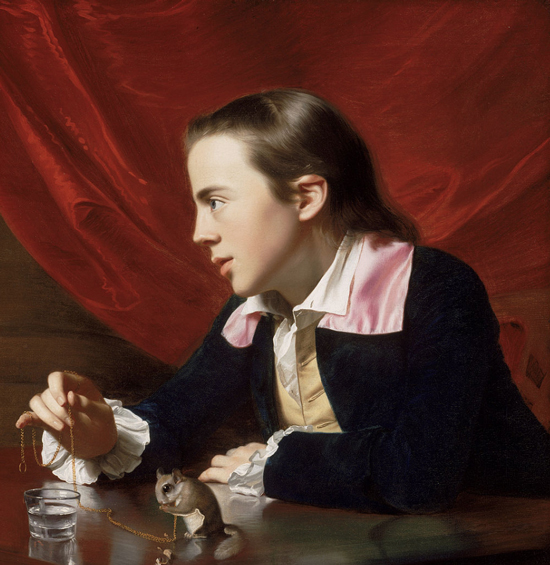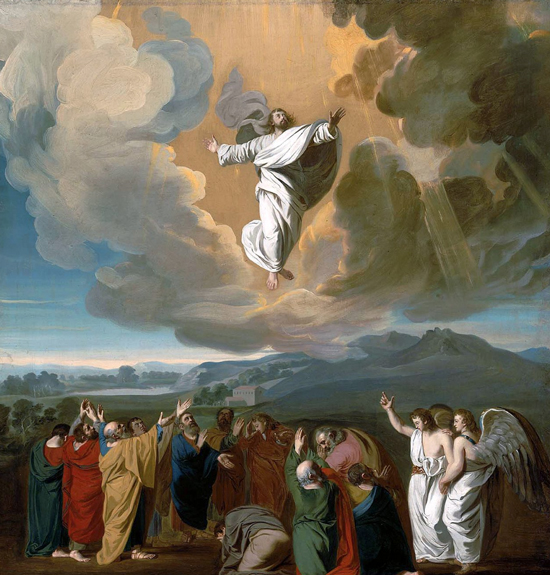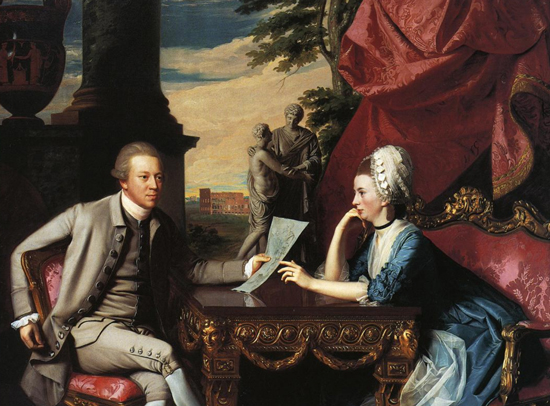John Singleton Copley was born on July 3, in Boston, Massachusetts. His parents were Irish immigrants named Richard Copley and Mary Singleton. After his father’s death in 1748, John’s mother married Peter Pelham, an engraver. Peter supported Copley’s early interest in art. Pelham died in 1751 and Copley followed in his footsteps, becoming an engraver. In his early teens, John published his first portrait, Reverend William Welsteed.
John’s goal was to become a history painter. He painted copies of engravings to history paintings with mythological themes. Some of these well-known works include Galatea, The Return of Neptune and The Forge of Vulcan. He also painted multiple figural groupings in works such as, The Brothers and Sisters of Christopher Gore and Mary and Elizabeth Royall.
Copley preferred bold colors and dramatic chiaroscuro in his paintings. These preferences can be seen in his colonial portraits. Copley studied the subjects of his portraits very closely. He was known for adding the materialistic values of his subjects into the portraits. Some of his portraits include Epes Sargent, John Bours and Mrs. Samuel Quincy (Hannah Hill). Copley produced works in a variety of media and sizes. He made portrait miniatures in oil on copper and in watercolor on ivory. He also worked with pastels for about ten years.
In 1766, Copley submitted Boy with a Squirrel, a portrait of his half brother, to the Society of Artists exhibition in London. This painting helped him get elected to the Society of Artists. The artists Joshua Reynolds and Benjamin West recognized Copley’s talent.
 |
| The Boy with the Squirrel (Henry Pelham) (1765) |
In 1767, Copley submitted Young Lady with a Bird and Dog to the Society of Artists in London. Reynolds and West told John that he would not improve if he did not travel abroad for training. Copley decided to stay in Boston and continue to paint Boston and New England merchants, lawyers, clergymen, and artisans, such as Paul Revere.
In 1769, Copley married Susanna Farnham Clarke, the daughter of two wealthy merchant families. They had six children, three of whom survived childhood. Copley obtained land on Beacon Hill, in close vicinity to John Hancock.
Copley spent seven months in New York, where he painted thirty-seven portraits. He began to portray figures emerging from dark backgrounds with greater contrasts and somber tones. Some of the paintings he made in New York include Mrs. Thomas Gage (Margaret Kemble), which he described as "Beyond compare the best lady's portrait I ever drew".
In June 1774, Copley traveled to England. He met up with West and Reynolds there. In August, John traveled to Rome by way of Paris. In Rome, Copley painted The Ascension, his first original history painting. He also made other works, such as a double portrait of Mr. and Mrs. Ralph Izard. In addition, he painted pictures with religious and mythological themes.
 |
| Ascension (1775) |
| |
 |
| Mr. and Mrs. Ralph Izard (1775) |
In October 1775, Copley returned to London to join his wife, father-in-law, and children. While in London, Copley learned to transfer his drawings to a larger scale. He also learned the English and Continental method of applying layers of transparent glazes. A year later, Copley made a portrait of The Copley Family that was over seven-feet-long. This was the first and only time he publicly displayed an image of himself. In 1777, he made an even larger family portrait, Sir William Pepperrell and His Family.
In 1778, Copley exhibited the painting Watson and the Shark, which won him full membership in the Royal Academy. This painting was the first sympathetic depiction of a black man by an American artist. The painting shows a sailor standing in the center of the canvas, staring at the conflict between man and nature.
During this time, Copley continued to make portraits of American Loyalists, British military figures, and English gentry, such as Admiral Clark Gayton, Admiral of the White and his wife, Mrs. Clark Gayton and Major Hugh Montgomerie, Later Twelfth Earl of Eglinton. He also continued to paint contemporary histories, combining historical events with portraiture in works such as The Death of the Earl of Chatham. This painting depicts more than fifty life portraits of lords in dramatic arrangements surrounding a dying hero. Copley became the first artist in England to create a one-picture exhibition, presenting The Death of the Earl of Chatham. This exhibition attracted twenty thousand people.
In 1784, Copley completed a contemporary history picture called The Death of Major Peirson. This is considered to be the greatest work of his career. The painting depicts a battle fought between the British and the French on the Isle of Jersey. A year later, King George III, asked Copley to paint his youngest daughters. This painting was called The Three Youngest Daughters of George III.
 |
| The Death of Major Peirson, in the 1781 Battle of Jersey (1783) |
For the next five years, Copley focused on The Siege of Gibraltar. The Corporation of the City of London commissioned this work in 1783. The painting depicts the British victory over the Spanish and French. It took Copley about eight years to complete.
In 1799, Copley completed The Victory of Lord Duncan, which celebrates a British victory against the Dutch. Copley did extensive research to convey the facts of the event as correctly as he could. This painting was not as popular as some of his others.
Copley and the president of the Royal Academy began to argue over power and academy rules. Copley's health began to fail, however, he continued to paint. Copley died in 1815 at his home in London.